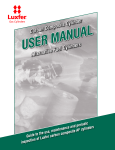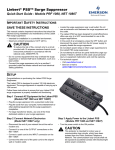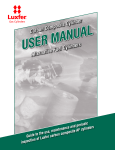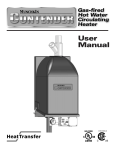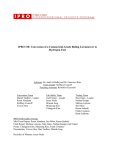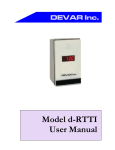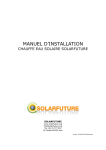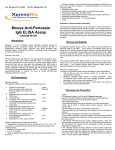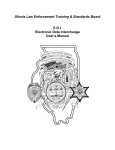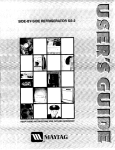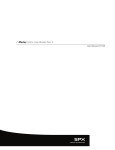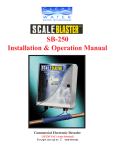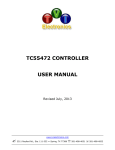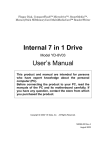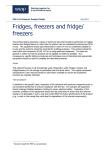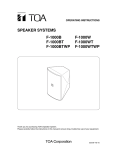Transcript
11361 Luxfer fitness check poster — 3rd stage:Layout 1 11/4/12 12:40 Page 1 The number one choice for SCBA users throughout the world, LCX® carbon composite cylinders have been designed to deliver outstanding performance and reliability: FITNESS CHECK 1 Care and maintenance 3 What your label tells you Luxfer recommends that these basic maintenance procedures be regularly followed for all Luxfer LCX® composite cylinders: ■ Ensure lubricants, if used, and components ■ Make sure the temperature of your cylinder does not exceed 82ºC (180ºF). Consider the are compatible with both the cylinder and the ambient temperature of the environment in gas mixture. which the cylinder is being used and the ■ Keep the inside of the cylinder free from duration of cylinder exposure, bearing in moisture, oil, dirt and other contaminants. mind that brief exposure to a high temperature does not necessarily mean the ■ Avoid completely discharging your cylinder, cylinder has reached that temperature. Any except for removal of the valve. cylinder believed to have reached a ■ Never artificially heat your cylinder. temperature of 82ºC or higher should immediately be removed from service and ■ Never remove, obscure or alter cylinder sent to an authorized cylinder requalification labels or markings. facility for evaluation before being used again. ■ For cylinder drying and repainting, see ■ Never use corrosive, caustic or acidic section 8 of the Luxfer LCX User Manual. strippers or solvents to remove paint or clean cylinder surfaces. 2 Pre-fill check list IS THE CYLINDER WITHIN ITS RETEST PERIOD? 1 7 8 11 10 9 14 13 12 15 6 5 4 3 2 17 16 18 1. Cylinder thread identity 2. Design specification (e.g., EN 12245) 3. Country of manufacture 4. Manufacturer’s mark 5. Cylinder serial number 6. UN number (referencing gas content) 7. Empty weight of cylinder 8. Minimum water capacity in litres 9. Filling pressure in bar 10. Test pressure in bar 11. Gas content 12. Maximum developed pressure 13. Date (year and month) of the first hydrostatic pressure test 14. Aluminium alloy of the liner 15. Operating temperature range 16. End-of-life date 17. Mark of conformity and notified body reference number according to the pressure equipment directive (97/23/EC) 18. Luxfer part number DO NOT FILL! NO Either 5 or 3 years after the test date on the label. Cylinders manufactured from February 2002 onwards, carrying the CE mark, can automatically be extended to a 5-year retest*. Cylinder must be retested by a requalification station authorised to test composite cylinders. See section 5 of the Luxfer LCX User Manual. ASSESS THE TYPE OF DAMAGE 1. PHYSICAL DAMAGE (*Subject to national regulations) 4 Valves For valving procedures, follow the SCBA manufacturer’s recommendations and any requirements in the country in which the cylinder and valve are being used. Valves should be torqued to a level not to exceed: e.g., abrasions, cuts, impact damage, delamination, chemical attack, illegible label. Cylinders manufactured before this date should be competently inspected at a 3-year interval and, if acceptable, can be extended to a 5-year retest period. LEVEL 1 – MINOR YES Level 1 Abrasion Level 1 Cut THREAD M18 X 1.5 6H 0.875-14 UNF 0.750-16 UNF 0.625-18 UNF MAX. TORQUE VALUE 100 NM (74 FT LBS) 108.46 NM (80 FT LBS) 101.68 NM (75 FT LBS) 67.7 NM (50 FT LBS) If the valve must be removed from the cylinder, follow the procedures and guidelines provided by the SCBA manufacturer, or follow the current edition of ISO 25760, Gas cylinders — Operational procedures for the safe removal of valves from gas cylinders. Level 1 Impact Continue with fill - go to step 3. IS THERE ANY EXTERNAL DAMAGE TO THE CYLINDER? We recommend an external inspection for damage before each fill. ■ Ultra-lightweight ■ Manufactured with the highest-grade materials ■ Exceptional strength and durability ■ Unmatched safety record ■ All cylinders conform to EN 12245 or ISO 11119-2 LEVEL 2 - REPAIRABLE YES 5 Filling Follow filling procedures recommended by the SCBA manufacturer. Only fill the cylinder with breathable air according to the SCBA manufacturer’s recommendations and any air quality requirements in the country in which the cylinder is being used. See section 6 of the Luxfer LCX User Manual. Level 2 Cut Level 2 Abrasion NO Upon repair, the cylinder must be retested and can then be returned to service. IS THERE ANY INTERNAL DAMAGE TO THE CYLINDER? LEVEL 3 - MAJOR/CONDEMNED We recommend an internal inspection every 5 years according to EN ISO 11623. Luxfer fully wrapped, carbon composite cylinder Level 3 Abrasion Each cylinder must be inspected internally to national standards or in accordance with EN ISO 11623. LUXFITCHECKUSA01 APR2012 Level 3 Impact High-strength fibreglassreinforced plastic (FRP) protective layer High-performance carbon fibre overwrap in epoxy resin matrix See section 6 of the Luxfer LCX User Manual for more information on damage levels and methods of repair. 2. HEAT DAMAGE If there is any concern that a cylinder has been heated to or above 82˚C for extended periods of time, or if a cylinder shows signs of heat damage, it should be requalified by an authorized retest station. REJECT fully wrapped composite cylinders with internal isolated corrosion pit(s) estimated to be deeper than 0.76 mm. REJECT all fully wrapped cylinders that exhibit bulges or dents on the inside of the liner. Level 3 Cut Cylinder must be condemned and removed from service! More frequent internal inspection is recommended if cylinders are charged with breathing air that is not dried or cleaned to recommended levels or when water may have been drawn into the cylinder. REJECT fully wrapped cylinders with sidewall line and broad-spread corrosion if any interior pit in the line corrosion is deeper than 0.5 mm or if the broad-spread corrosion is deeper than 0.5 mm. PLEASE NOTE: Some movement of the composite material during filling and discharging may cause a crackling noise, which is normal and no reason for concern. In addition, when the cylinder is pressurized, a slight opening in the composite material sometimes appears where the neck meets the shoulder; this is caused by differences in relative expansion of the neck and shoulder composite structures. Since the neck-to-shoulder transition is a low-stress area, such crack-like openings are strictly cosmetic and not a cause for concern. See section 5.1 of the Luxfer LCX User Manual. YES DO NOT FILL! Precisionmachined thread Lightweight aluminium liner Smooth, inert, corrosion-resistant internal finish See section 5.3 & 6 of the Luxfer LCX User Manual. Please display this poster in a prominent place in SCBA maintenance areas. Produced by: Luxfer Gas Cylinders. www.luxfercylinders.com • Tel: + 44 (0) 115 980 3800 • Fax: + 44 (0) 115 980 3899 For additional copies of this poster, please contact [email protected] NO FILL Go to step 4. ISO 11623:2002 (Transportable gas cylinders – Periodic inspection and testing of composite gas cylinders) ISO 11119-2:2002 (Gas Cylinders of composite construction – Specifications and Test Methods – Fully wrapped fibre reinforced composite gas cylinders with load-sharing metal liners)
